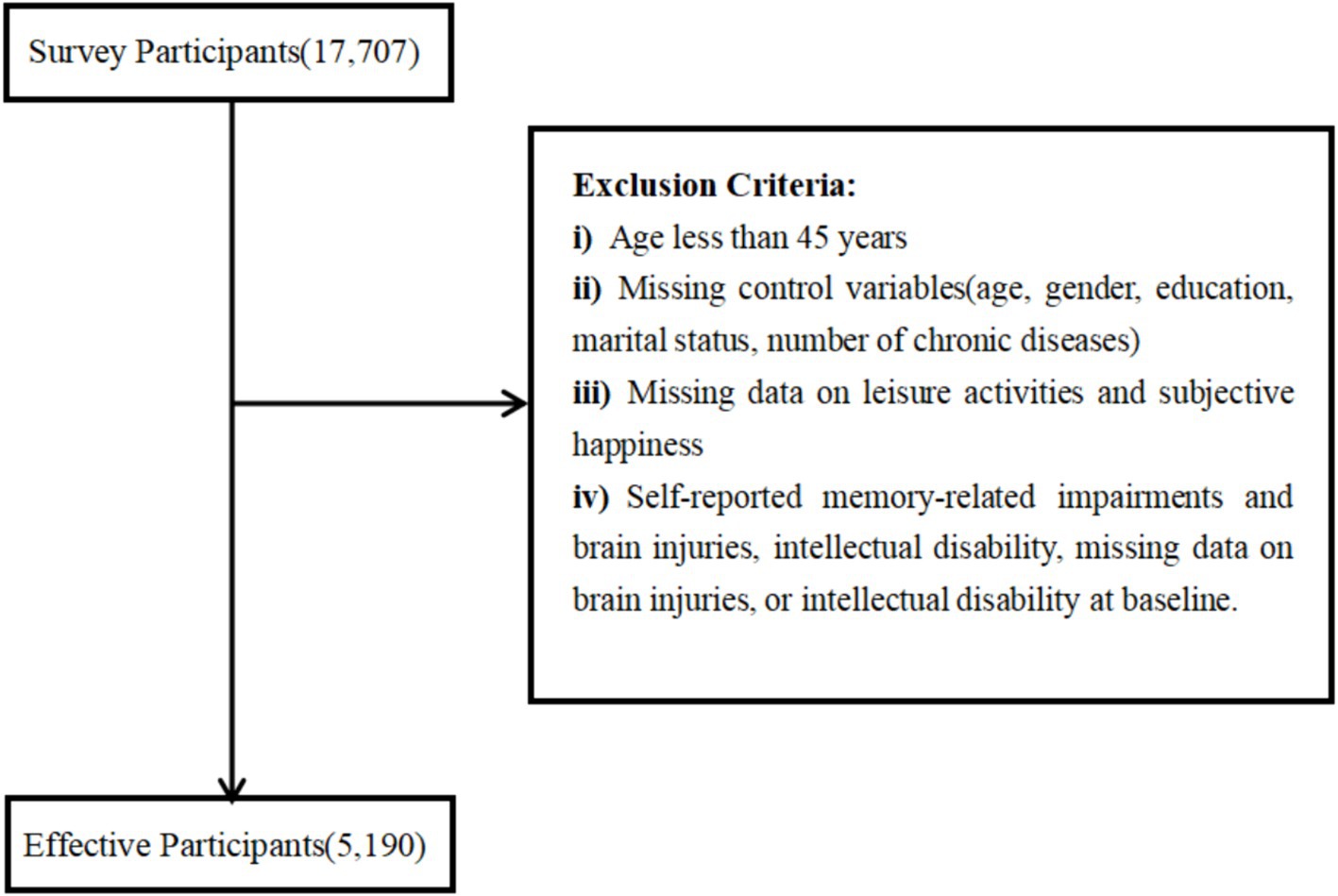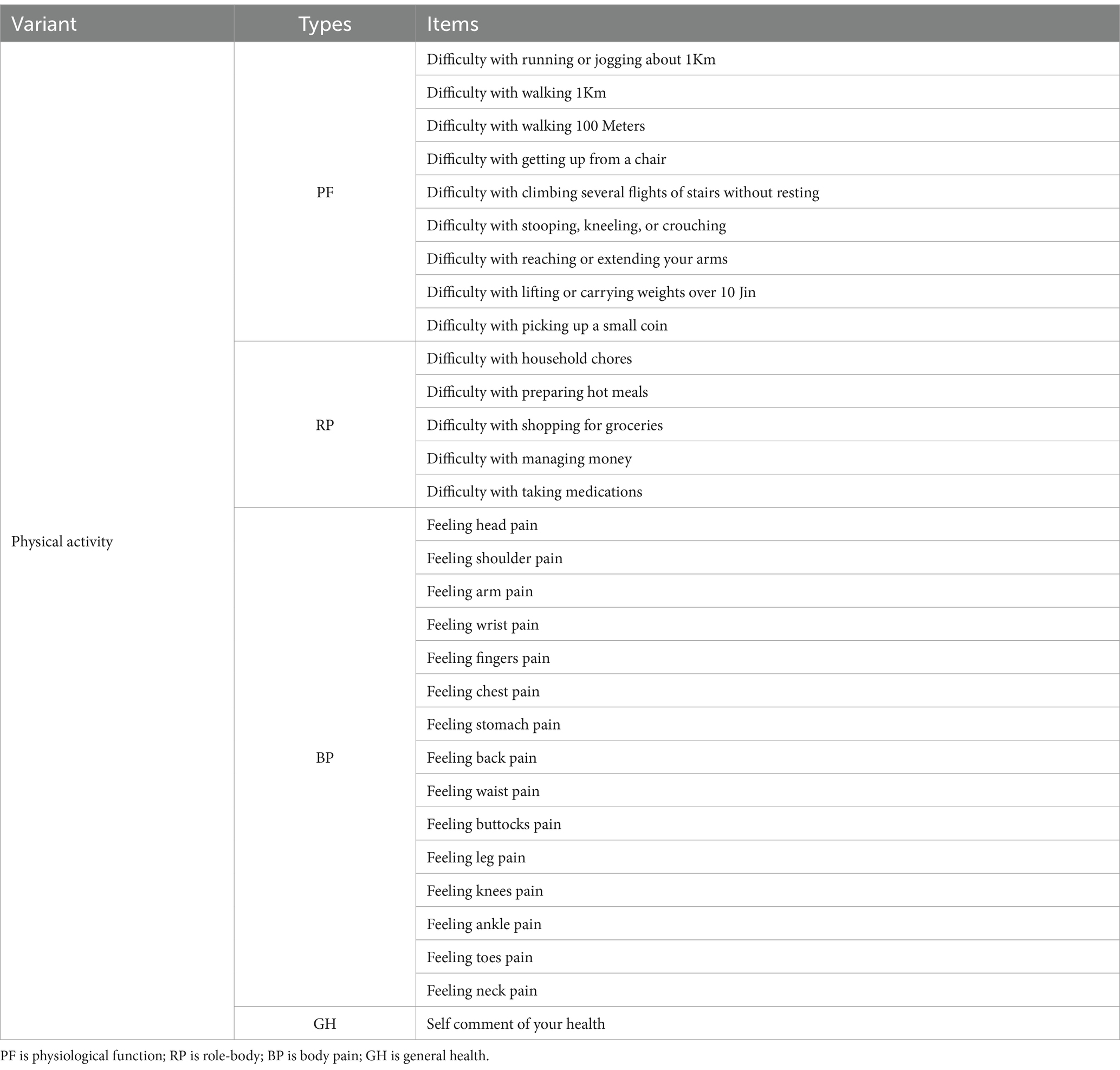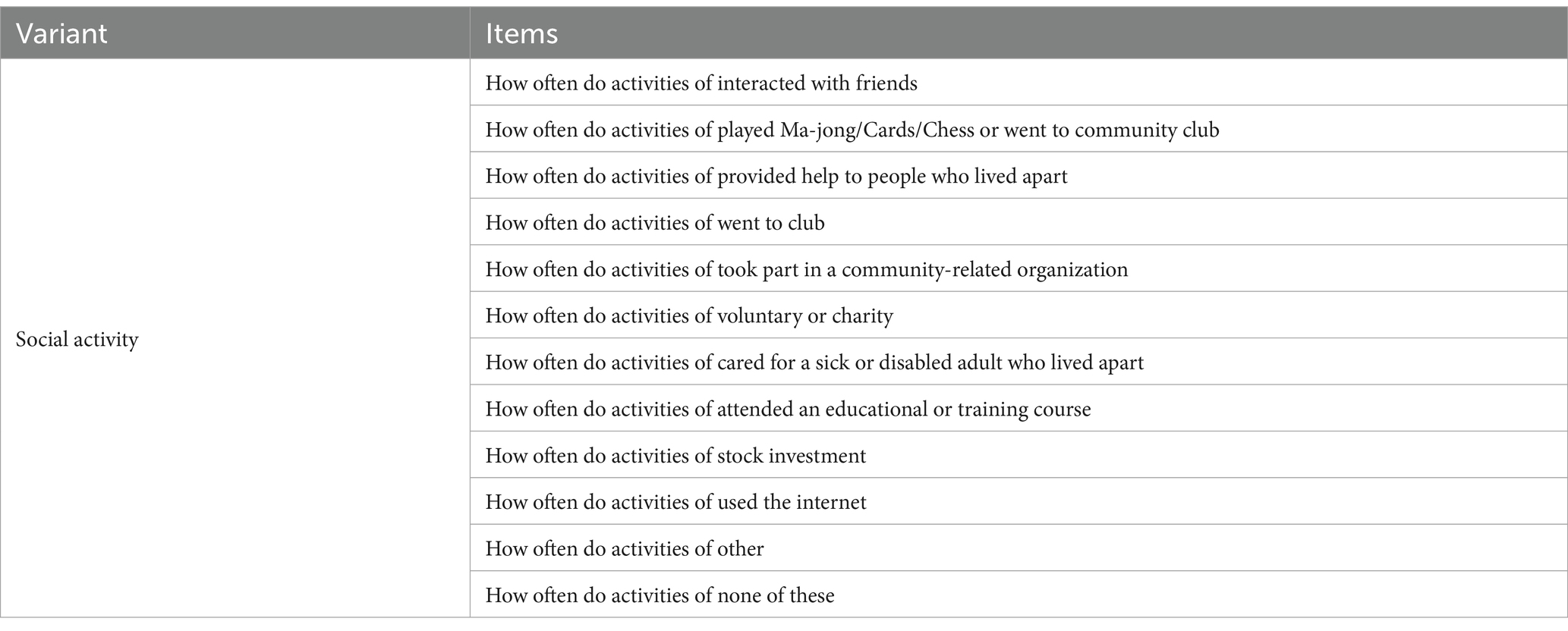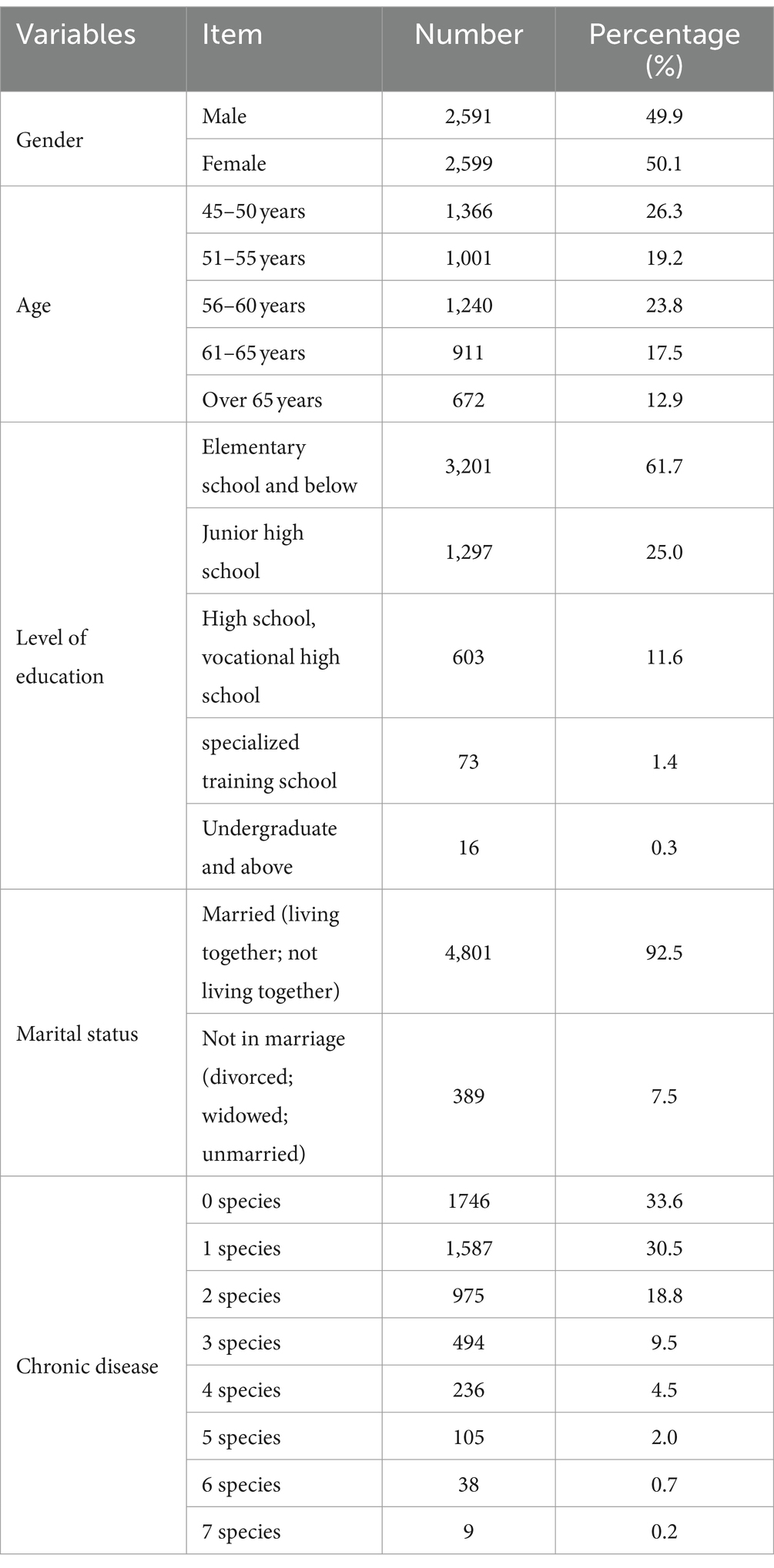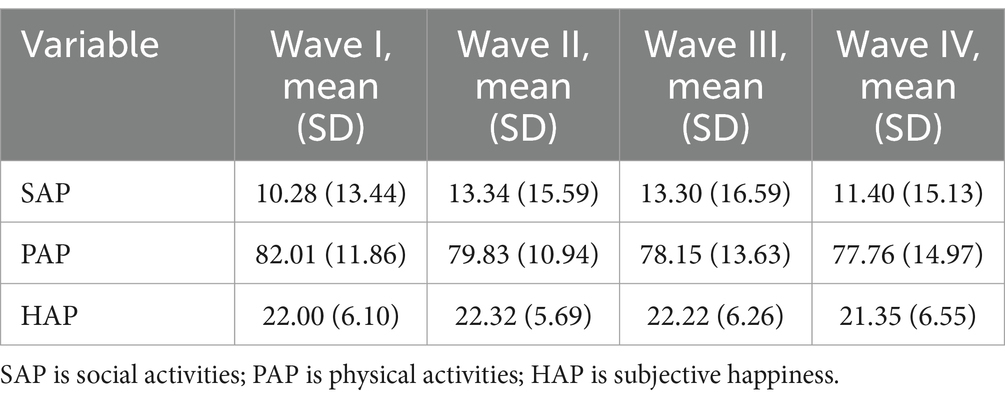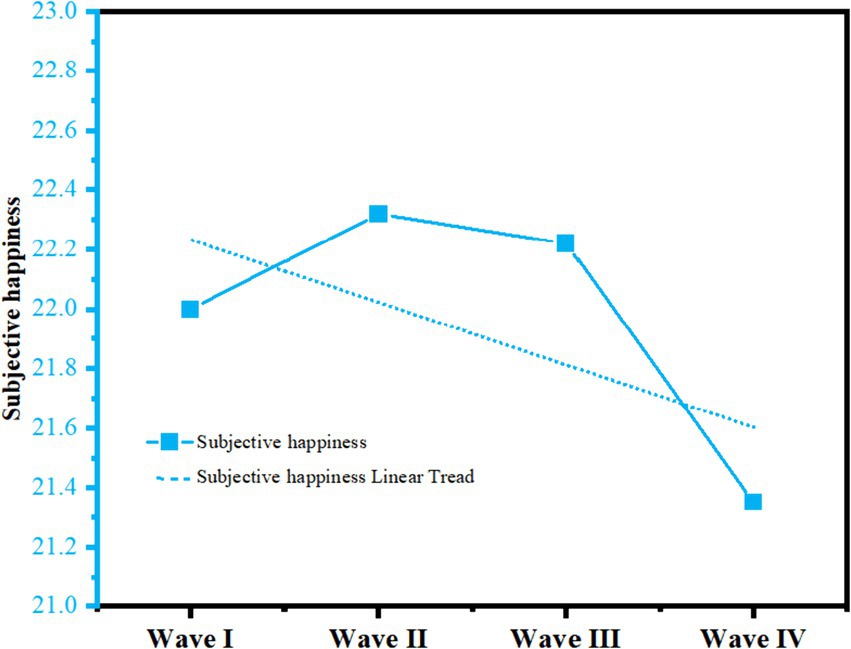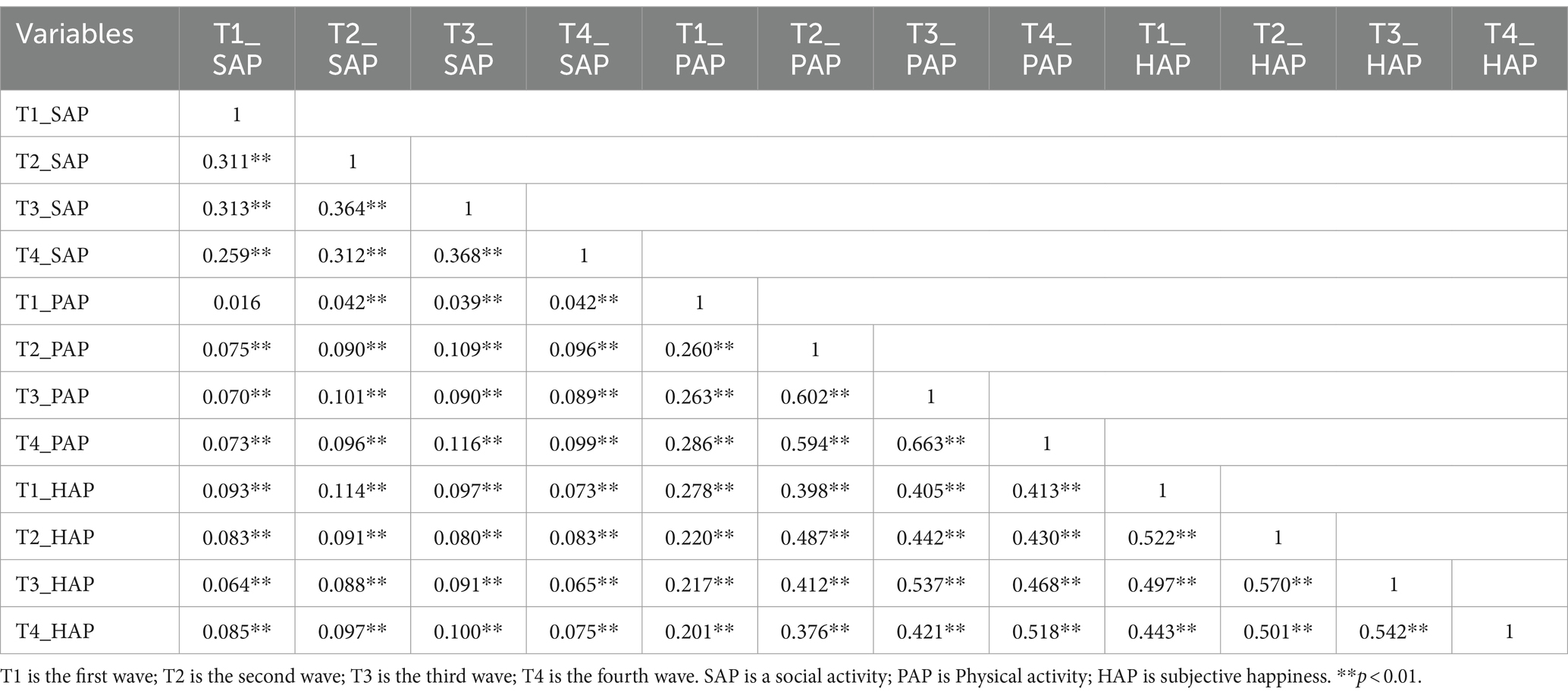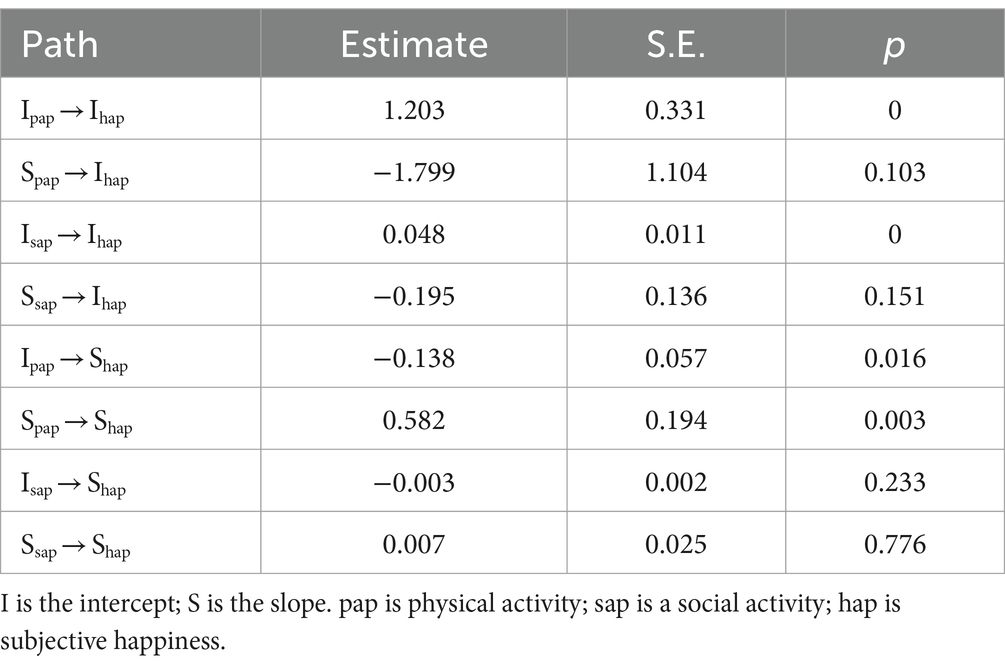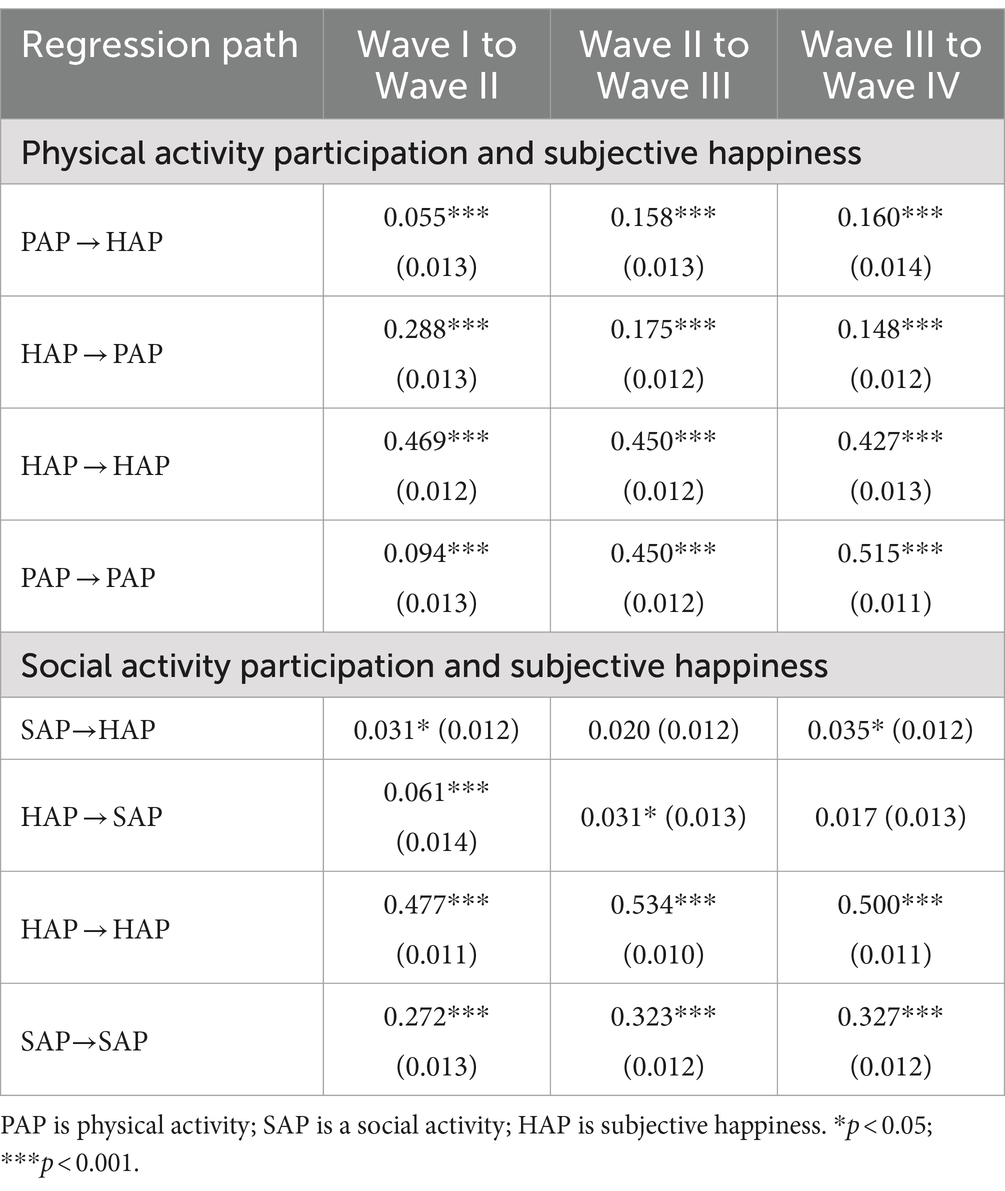- School of Physical Education, Shandong University, Jinan, China
Background: Leisure activities serve as key measures to enhance the subjective happiness of middle-aged and older adults individuals and to positively address the challenges of an aging society; however, the trajectory of changes in their participation in leisure activities and how these changes relate to shifts in subjective happiness have not been adequately explored.
Methods: This study selected data from the China Health and Aging Longitudinal Study (CHARLS), which included a total of 5,190 middle-aged and older adults people. Linear and nonlinear latent growth models, parallel latent growth models and cross-lagged models were constructed to investigate the influence and lagged relationship between the trajectory of changes in the level of participation in leisure activities on the trajectory of changes in the subjective well-being of middle-aged and older adults people.
Results: The initial level of physical activity participation of middle-aged and older adults people significantly predicted the initial level (β = 1. 203, p < 0.001) and rate of change (β = −0.138, p = 0.016) of their subjective well-being, and the trajectory of change of middle-aged and older adults people’s physical activity also significantly predicted the rate of change of their subjective well-being (β = 0.582, p = 0.003). Meanwhile, the initial level of social activity of middle-aged and older adults people also effectively predicted the initial level of their subjective well-being (β = 0.048, p < 0.001). At the same time, the covariates (gender, age, level of education, marital status, chronic disease) also predicted the initial level and rate of change of leisure activity participation level and subjective well-being. Finally, the cross-lagged model test confirmed the predictive effect of leisure activity participation level on subjective well-being of middle-aged and older adults people.
Conclusion: This study confirms that the level of participation in leisure activities of Chinese middle-aged and older adults people has a significant predictive effect on their subjective happiness and that there is a significant correlation between the trajectory of changes in the level of participation in leisure activities and the trajectory of changes in subjective happiness.
Background
The subjective happiness of middle-aged and older adults people is a subjective evaluation of their quality of life, which is closely related to their physical and mental health. According to data from the seventh national population census, there are more than 264 million older adults people aged 60 and above in China, accounting for 18.70 per cent of the total population, which is a deepening of the aging of China’s population compared with the 10.3 per cent recorded in 2000 (1). At present, subjective happiness has become an important indicator of the quality of life of the older adults in their later years and the key to positively coping with the aging of the population and has received more and more attention from scholars (2, 3). The subjective happiness of many middle-aged and older adults individuals has been significantly impacted by COVID-19. The suddenness and unpredictability of the pandemic have posed serious threats to mental health and a sense of security globally, leading to a decline in overall well-being (4). The social isolation measures taken by governments to reduce the spread of the virus have led to a lack of social support and a sense of isolation among the majority of older adults people, which also has a serious impact on their subjective sense of well-being (5).
Subjective happiness plays a crucial role in the well-being of middle-aged and older adults people. It is closely intertwined with individual cognition (6). For example, older adults with mild cognitive impairment typically experience lower levels of subjective happiness compared to those with normal cognitive abilities (7). Additionally, subjective happiness is strongly linked to psychological health, with higher levels of happiness predicting greater life satisfaction and more positive emotions (8). Social relationships also play a significant role; social support, for instance, can mitigate the impact of dissatisfaction with one’s image on subjective happiness (9). Furthermore, research suggests that subjective happiness provides strong support for both the physical and mental health of middle-aged and older adults individuals (10). When subjective happiness is low in old age, there will be serious consequences such as decreased physical and mental health, frequent illnesses, and even suicide (11).
Therefore, affected by COVID-19, the lower subjective happiness of middle-aged and older adults people (12, 13) and how to enhance their subjective happiness and thus promote the physical and mental health of middle-aged and older adults people is an important issue that needs to be studied urgently. Activity theory finds that people accomplish specific goals by engaging in activities that promote the development of their psyche and consciousness in the process of engaging in activities and improve subjective happiness (14). At the same time, positive psychology has also found that people’s participation in leisure activities can effectively promote individual psychological health and thus improve their subjective happiness (15). Positive psychology has also found that participation in leisure activities is effective in promoting psychological well-being and subjective happiness. Related studies have also confirmed this idea, for example, in a study of Chilean adolescents, it was found that physical activity can help adolescents to self-regulate their emotions and reduce the impact of negative emotions on themselves, thus improving their subjective happiness (16). The study found that physical activity helped adolescents to self-regulate their emotions and reduce the impact of negative emotions on themselves, thereby increasing subjective happiness. During the COVID-19 epidemic, a review of the impact of contemporaneous physical activity on the mental health of adults confirmed that the epidemic and closure measures led to an increase in sedentary behavior and a decrease in physical activity levels, leading to unhealthy psychological problems such as stress, anxiety, and isolation (17). Health behavior theory suggests that people engage in behaviors, including moderate exercise, socialization, dietary modification, and cessation of bad habits, to improve their physical health, cure illnesses, or increase fitness, thereby enhancing their subjective happiness (18). This theory is supported by relevant studies. For instance, the World Health Organization has suggested that appropriate physical activity can help individuals overcome sedentary behaviors and other unhealthy habits, thereby improving their overall physical health (19). Additionally, in a review study of cancer patients, it was found that those who engaged in regular physical activity experienced better physical health and a higher quality of life compared to those who did not (20). In addition, the theory of need satisfaction suggests that in leisure activities, people can be free from external pressures and free to do what they love, from which they can gain a sense of satisfaction and achievement and satisfy the individual’s need for self-fulfilment. At the same time, the theory also suggests that individual happiness mainly comes from the satisfaction of one’s own needs. Therefore, when people actively participate in leisure activities, their needs for leisure are satisfied, and they will have a sense of happiness (21). The above theories and studies may suggest that leisure activities may improve an individual’s physical health. These theories and studies suggest that leisure activities may have a positive predictive effect on subjective happiness.
However, previous studies usually treat the level of leisure activity participation and subjective happiness as time-invariant variables and simply verify the correlation between the initial levels of the variables (22, 23) and few studies have explored the interaction between leisure activity trajectories and subjective happiness trajectories. Therefore, in this study, linear and nonlinear latent growth models were constructed to examine the initial level and rate of change of the participation in leisure activities (physical and social activities) and subjective happiness of middle-aged and older adults people, using data from four waves of the China Health and Aging Longitudinal Study (CHARLS) spanning a total of 7 years. The parallel latent growth model and the cross-lagged model are also used to investigate the influence of the trajectory of the change in the level of participation in leisure activities on the trajectory of the change in subjective happiness of the middle-aged and the lagged relationship between the level of participation in leisure activities and subjective happiness of the middle-aged and the older adults. We hope to provide theoretical references for improving the subjective happiness of the middle-aged and the older adults and actively coping with population aging.
Methods
Sample and data collection
The research data were drawn from the China Health and Retirement Longitudinal Study (CHARLS) database, a national survey that began in 2011. The survey encompassed 150 countylevel units, 450 village-level units, and approximately 10,000 households, covering a total of more than 17,000 individuals. Follow-up surveys were conducted in 2013, 2015, and 2018. The samples for these surveys were selected using a probability sampling method, with probabilities proportional to the population size at each stage of selection—sequentially at the county, village (or neighborhood), household, and individual levels. More details on the CHARLS database can be found in previous publications (24). Four waves of data from this database in 2011 (Wave 1), 2013 (Wave 2), 2015 (Wave 3), and 2018 (Wave 4) were selected for investigation in this study, with a follow-up survey for valid participants in 2011 (Wave 1).
The purpose of this study was to examine the relationship between leisure activities and subjective happiness among middle-aged and older adults based on a longitudinal study with control of relevant variables. Therefore, the sample exclusion criteria for this study were: age less than 45 years (498 people), missing covariates (age, gender, education, marital status, number of chronic diseases) (466 people), missing participation in leisure activities (4,856 people), missing subjective happiness (4,120 people), self-reported memory-related impairments and brain injuries, intellectual disability, missing data on brain injuries, or intellectual disability at baseline (2,577 people). Ultimately, a total of 5,190 respondents were included after the above operational exclusions (Figure 1).
Ethical considerations
This study was organized by the National Institute of Development Studies, Peking University, according to the ethical guidelines of the 1975 Declaration of Helsinki, and was approved by the Ethics Committee of Peking University (approval number: IRB00001052-13074). Research involving human participants was approved for review by the Ethics Research Committee of Peking University (approval number: IRB00001052-11015), and subjects gave informed written consent to participate in this study.
Leisure activity
This study combines the definitions of previous scholars (25) and the characteristics of Chinese middle-aged and older adults people’s leisure activities to classify their leisure activities into physical activities and social activities (26). Based on the characteristics of the CHARLS data, the participation in leisure activities of the middle-aged and older adults was categorized into participation in physical activities (activities related to physical exercise) and participation in social activities (activities related to socializing and making friends).
In addition to this, previous studies have typically measured physical activity participation only through metrics such as exercise intensity, duration, and days of participation (27). Therefore, to reflect the level of physical activity participation of middle-aged and older adults people more comprehensively, the present study, based on combining previous studies and the CHARLS HRQOL scale (28, 29) In this study, we chose to demonstrate the level of physical activity participation of middle-aged and older adults people more comprehensively from the four aspects of PF (physiological function), RP (role-body), BP (body pain), and GH (general health). In this study, PF (Physiological Functioning) mainly measures the level of difficulty in physical activity participation of middle-aged and older adults people; RP (role-body) measures the limitation of physiological cognition on the participation of middle-aged and older adults people in physical activity; BP (Body Pain) is to measure the limitation of physical pain on the participation of middle-aged and older adults people in physical activity; and GH (General Health) is to measure the influence of health status on the participation of middle-aged and older adults people in physical activity. Regarding the measurement of the level of social activity participation, this study referred to previous related studies (30), which measured the total types of social activities that middle-aged and older adults people participated in and the frequency of participation in social activities in the past month. The items measuring physical and social activity were taken from the CHARLS database, and the items did not change over the four waves of data, as shown in Tables 1, 2.
In this study, partial data of the two types of activity measures were assigned in reverse to ensure that higher scores indicate more active participation in activities. Meanwhile, according to the scoring rules of the SF-36 scale, physical activities were divided into 4 dimensions, and each question item was assigned a score according to a scale of 1–4, while social activities were assigned a score of 1 for participation in an activity. Raw scores for the degree of participation in the 2 types of activities in their respective components were computed, and scores for the 2 types of activities were converted to a range of 0–100 for analyses (28, 29). The total score for both physical activity and social activity was 100. Finally, the Cronbach’s α coefficients for the physical activity participation level and the social activity participation level were 0.764 and 0.655, respectively, and the Cronbach’s α coefficients for the 2 activity participation levels were greater than 0.6, indicating that this scoring method has a certain degree of reliability.
Subjective happiness
Subjective happiness in this study was measured using the CHARLS Depression Scale (CES-D), which is a simplified version of the depression scale developed by Radolff of the National Institute of Mental Health in the U.S. Relevant studies have demonstrated that the CES-D can also be applied to middle-aged and older adults people in China (31). The CES-D consists of 10 questions that measure the subject’s worry, energy, fear, sleep quality, happiness, hope, and other dimensions, and is effective in measuring subjective happiness (32). In this study, the relevant data were reverse-assigned to ensure that the higher the subject’s score, the higher the subjective happiness. Each question was scored using a four-level scale, with each question item maintaining a score ranging from 0–3, and the total score ranging from 0–30, and the Cronbach’s alpha coefficient for subjective happiness was 0.806 greater than 0.6, which indicates that this type of scoring method has a high degree of reliability.
Control variable
The Control Variable in this study mainly included age, gender, education level, marital status, and number of chronic diseases of the subjects (Table 3). All covariates were measured during the first wave (WAVE 1) of the survey and were included in the study as covariates of the initial level and rate of change in the level of participation in leisure activities (physical and social activities) and subjective happiness among middle-aged and older adults. Gender was categorized as “male” and “female”; age was categorized as “45–50 years” “51–55 years” “56–60 years” “61–65 years” and “Over 65 years”; education level was categorized as “Elementary school and below” “junior high school” “High school, vocational high school” “specialized training school” “Undergraduate and above.” Marital status includes “married” and “not married.” Chronic diseases are self-reported and labeled 0–14 depending on the number of chronic diseases.
Results
Common method bias testing
To avoid the influence of a single sample on the increase or decrease of correlation between dimensions and to ensure the scientific validity of the study. Therefore, this study conducted a Harman’s one-way test on the data, such methods are usually used as a test of the extent of common method bias, the results of the test showed that the first factor explains 34.7% of the variance, which is less than the desirable value of 40%, so there is no common method bias in this study (33).
Statistical description
Statistical descriptions of the 3 categories of variables at baseline are shown in Table 4, and the results indicate that from 2011 to 2018, the level of participation in social activities, the level of participation in physical activities, and the subjective happiness of middle-aged and older adults have ranged from 10.28 (13.44) to 11.40 (15.13), and from 82.01 (11.86) to 77.76 (14.97) versus 22.00 (6.10), respectively to 21.35 (6.55), Figures 2, 3 below show more clearly the scores and trends of the three types of variables. Table 5 shows the correlation between social activity participation, physical activity participation, and subjective happiness in the four surveys, and as expected, the results show a significant positive correlation between social activity participation, physical activity participation, and subjective happiness from 2011 to 2018.
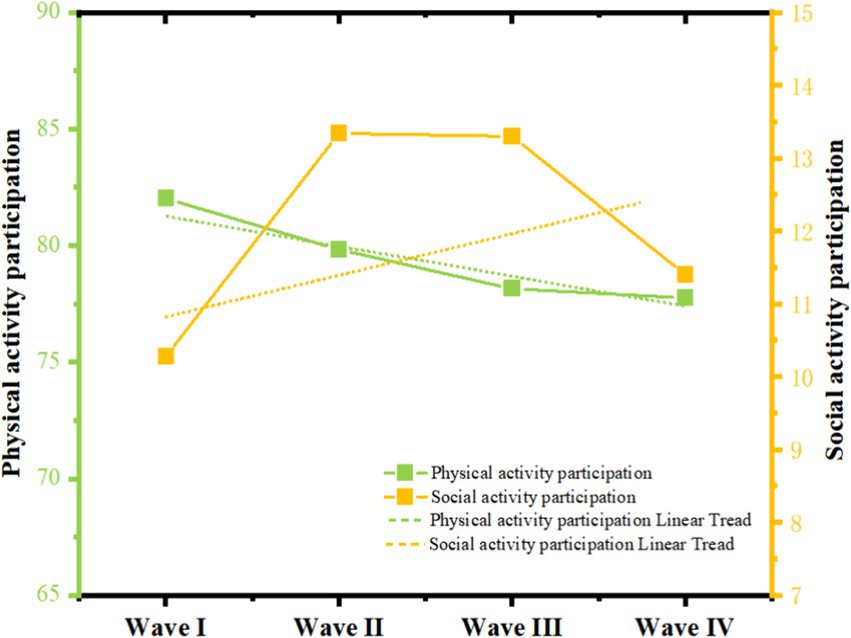
Figure 2. Trajectory of participation levels in leisure activities (physical and social activities).
Trajectories of physical and social activity participation among middle-aged and older adults
To explore the relationship between subjective happiness and the participation level of leisure activities (physical activities and social activities) among middle-aged and older adults people, we used unconditional linear and nonlinear models to assess the initial subjective happiness, physical activity participation level, social activity participation level of middle-aged and older adults people, as well as the trajectory of their changes over time, and the relevant results and model fit indices, are shown in Table 6.
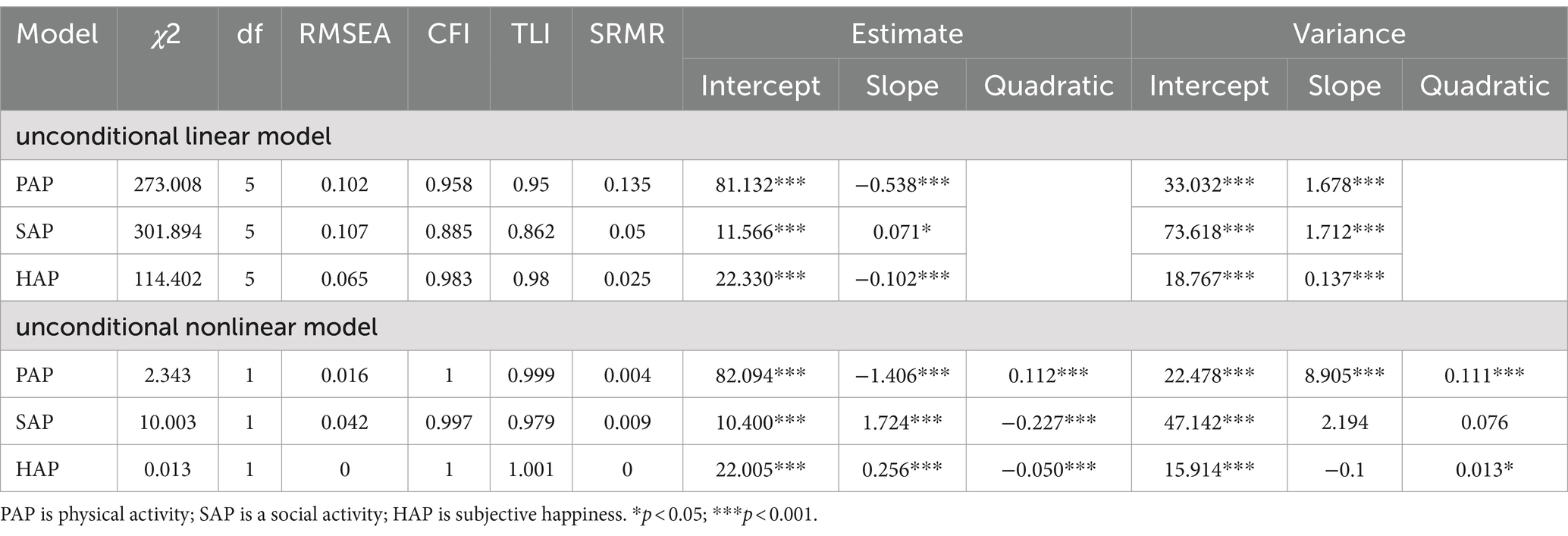
Table 6. Unconditional linear and nonlinear latent variable growth model fit indices and model results.
As shown in Table 6, the fit of the nonlinear model for the potential growth of physical activity participation levels for middle-aged and older adults people was better than the linear model, so the nonlinear model for physical activity participation was chosen for the study. The slope of the quadratic variance of the level of physical activity participation was 0.111 (p < 0.001), the initial level (intercept) of physical activity participation was 82.094 (p < 0.001), the level of physical activity participation decreased year by year in the 4-wave test (slope = −1.406, p < 0.001), and the rate of decline increased year by year (slope = 0.112, p < 0.001), indicating that physical activity participation level has a non-linear decreasing trend in the 4-wave test. Meanwhile, the intercept variance and slope variance of physical activity participation levels were 22.478 (p < 0.001) & 8.905 (p < 0.001), respectively, indicating a significant difference in the rate of decline among individuals.
As shown in Table 6, for the level of social activity participation of middle-aged and older adults people, the potential growth nonlinear model fit better than the linear model, so the quadratic term model of the level of social activity participation was chosen to be analyzed in this study. The initial level (intercept) of social activity participation was 10.4 (p < 0.001), and the level of social activity participation increased year by year in the 4-wave test (slope = 1.724, p < 0.001), and the growth rate decreased year by year (slope = −0.227, p < 0.001), indicating that the level of social activity participation showed a nonlinear growth trend in the 4-wave test. The intercept variance and slope variance of the social activity participation level were 47.142 (p < 0.001) & 2.194, respectively.
Subjective happiness trajectories in middle-aged and older adults
As shown in Table 6, for the subjective happiness of middle-aged and older adults people, although the goodness of fit of both linear and nonlinear models of their potential growth is acceptable, the quadratic slope variance and quadratic variance of the nonlinear model are not significant. Therefore, the linear model was chosen for analysis in this study. The results showed that the intercept variance and slope variance of subjective happiness were 18.767 (p < 0.001) and 0.137 (p < 0.001), respectively, which indicated that there were significant differences in the initial level and rate of decline of subjective happiness among middle-aged and older adults individuals. Meanwhile, the slope of subjective happiness was −0.102 (p < 0.001), indicating that subjective happiness showed a linear decreasing trend from year to year in the 4 waves of the test.
Parallel LGCM
In order to more accurately study the relationship between subjective well-being and leisure activities of middle-aged and older adults people, as well as the trends of both over time, we used a parallel LGCM in this section (Figure 4). The parallel LGCM focuses on the relationship between the intercept and slope of physical activity participation and social activity participation on the intercept and slope of subjective happiness. Unstandardized coefficients were reported inside the parallel latent growth model due to the 0.9+ correlation between the intercept for physical activity and the intercept for well-being in the parallel latent growth model. As shown in Table 7, the fit index of the parallel latent growth model constructed by the level of participation in leisure activities (physical activities and social activities) and subjective happiness of middle-aged and older adults people is in the acceptable range.
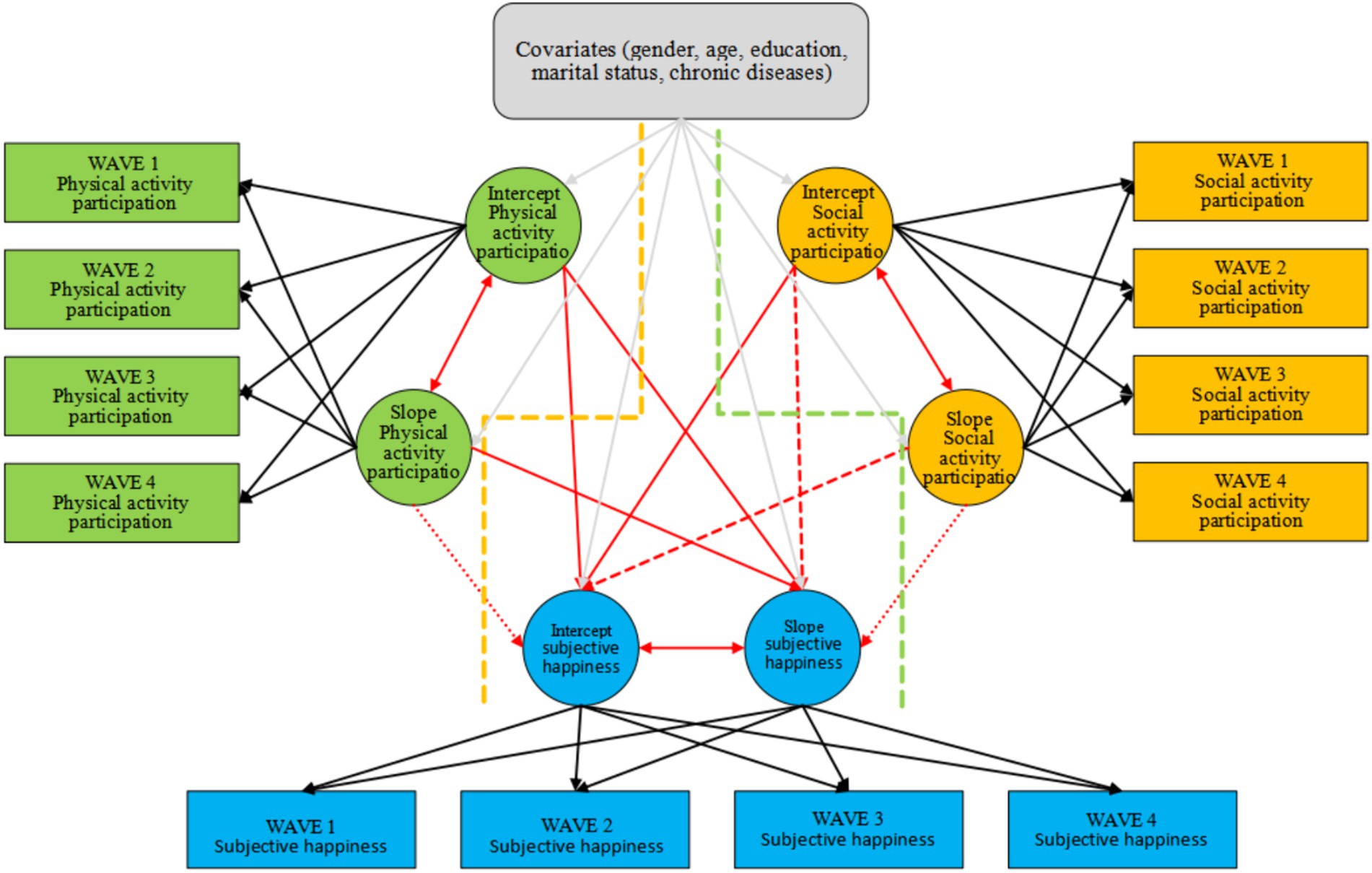
Figure 4. Parallel latent growth model of leisure activity participation level and subjective happiness of middle-aged and older adults people. Valid and invalid paths are indicated by solid and dashed lines, respectively.
In Figure 4 effective and ineffective routes are represented by solid and dashed lines, respectively. The results of the study are shown in Table 8, first from the initial level of subjective happiness of middle-aged and older adults people. There is a positive effect of the initial level of physical activity participation on the initial level of subjective happiness (β = 1.203, p < 0.001), indicating that the higher the initial level of physical activity of middle-aged and older adults people, the higher the subjective happiness. However, the rate of decline in the level of participation in physical activity was not correlated with the initial level of subjective happiness (β = −1.799, p = 0.103). Meanwhile, the initial level of social activities positively affected the initial level of subjective happiness (β = 0.048, p < 0.001), indicating that the higher the initial level of social activities, the stronger the subjective happiness of middle-aged and older adults people. However, the rate of increase in the level of participation in social activities was not correlated with the initial level of subjective happiness (β = −0.195, p = 0.151).
As shown in Table 8, on the other hand, from the subjective happiness decline rate of middle-aged and older adults people, the initial level of physical activity participation negatively predicts the decline rate of subjective happiness (β = −0.138, p = 0.016), indicating that the higher the initial level of physical activity participation, the slower the decline rate of subjective happiness. Meanwhile, the decline rate of physical activity participation has a positive effect on the decline rate of subjective happiness (β = 0.582, p = 0.003), indicating that the higher the decline rate of middle-aged and older adults people’s physical activity participation, the faster the decline rate of their subjective happiness. In contrast, both the initial level (β = −0.003, p = 0.233) and the rate of increase (β = 0.007, p = 0.776) of middle-aged and older adults people’s participation in social activities were not correlated with the rate of decline in subjective happiness.
According to Table 9, the number of chronic diseases has a significant effect on the initial level of subjective happiness of middle-aged and older adults people (β = 1.617, p < 0.05), indicating that middle-aged and older adults people with a lower number of chronic diseases have a higher initial level of subjective happiness. There is a significant effect of education level and age on subjective happiness of middle-aged and older adults people (β = 0.164, p < 0.05; β = 0.019, p < 0.05), indicating that the higher the education level and the older the middle-aged and older adults people, the faster the rate of decline of subjective happiness. Middle-aged and older adults people’s gender, education level, age, and chronic diseases all had a significant effect on their initial level of physical activity (β = −1.897, p < 0.001; β = 1.486, p < 0.001; β = 0.039, p < 0.001; β = −2.495, p < 0.001), indicating that the higher the level of education of middle-aged and older adults people, the higher the level of education of middle-aged and older adults people, and the higher the age of middle-aged and older adults, and the lower the number of chronic diseases, the higher the initial level of physical activity participation. The gender, education level, age and chronic diseases of middle-aged and older adults people all also have a significant effect on the rate of decline in physical activity (β = −0.415, p < 0.001; β = 0.133, p < 0.001; β = −0.020, p < 0.001; β = −0.165, p < 0.001), indicating that middle-aged and older adults females, middle-aged and older adults people with less education, older middle-aged and older adults people, and the lower number of chronic diseases older middle-aged and older adults, and middle-aged and older adults with a higher number of chronic diseases have a slower rate of decline in physical activity participation. The significant effects of gender, education level, and age on the initial level of participation in social activities (β = −1.575, p < 0.001; β = −2.928, p < 0.001; β = −0.155, p < 0.001) indicate that middle-aged and older adults males, middle-aged and older adults people with higher education levels, and middle-aged and older adults people with lower ages have higher initial levels of participation in social activities. The gender and education level of middle-aged and older adults people have a significant effect on the growth rate of their social activities (β = 0.219, p < 0.001; β = 0.247, p < 0.001), indicating that middle-aged and older adults women and middle-aged and older adults people with higher education levels have a faster growth rate of participation in social activities.

Table 9. Effect of covariates on leisure activities (physical activities, social activities) and subjective happiness of middle-aged and older adults people.
Cross-lag model
Cross-lagged modeling is the best way to test the “single” effect between variables (34). In the present study, the cross-lagged model was used to further examine the relationship between the level of participation in leisure activities (physical and social activities) and the subjective happiness of middle-aged and older adults people over time and to verify the robustness of the predictive effect of the level of participation in leisure activities (physical and social activities) on the subjective happiness of middle-aged and older adults people. However, it is worth noting that latent variable cross-lagged models are prone to saturated models and usually do not require excessive attention to model fit indices; therefore, the fit indices of cross-lagged models are not reported in this study (35).
As shown in Figure 5, it was found that the level of physical activity participation of middle-aged and older adults people in the first wave significantly and positively predicted the subjective happiness of middle-aged and older adults people in the second wave (β = 0.055, p < 0.001) through the study of the results of the 4 waves of survey. The level of participation in physical activity in the second wave of middle-aged and older adults people significantly and positively predicted the subjective happiness of middle-aged and older adults people in the third wave (β = 0.158, p < 0.001). The third wave of the physical activity participation level of middle-aged and older adults people significantly positively predicted the fourth wave of subjective happiness (β = 0.160, p < 0.001). Meanwhile, the subjective happiness of middle-aged and older adults people in the previous wave also had a significant positive predictive effect on their physical activity participation, and the results are shown in Table 10.

Figure 5. Cross-lagged model of physical activity participation level and subjective happiness of middle-aged and older adults people.
As shown in Figure 6, the cross-lagged model of middle-aged and older adults people’s social activity participation level and subjective happiness demonstrated similar results. In the first wave of middle-aged and older adults In the second wave, the situation of middle-aged and older adults social activity participation level has a significant positive predictive effect on the subjective happiness of middle-aged and older adults in the second wave (β = 0.031, p < 0.05). There was no significant correlation between the level of participation in social activities of middle-aged and older adults people in the second wave and their subjective happiness in the third wave (β = 0.020, p = 0.092). There was a significant positive prediction of the third wave of physical activity participation of middle-aged and older adults people on their fourth wave of subjective happiness (β = 0.035, p < 0.05). At the same time, older adults’ subjective happiness also had a significant positive effect on their subsequent level of social activity participation, and the results are shown in Table 10.

Figure 6. Cross-lagged model of social activity participation level and subjective happiness of middle-aged and older adults people.
Discussion
Based on data from four CHARLS surveys, this study examined the predictive role of trajectories of change in the participation levels of leisure activities (physical and social activities) of older adults on the trajectories of change in their subjective well-being. First, this study constructed unconditional linear and nonlinear models to assess the initial subjective well-being, initial physical activity participation level, initial social activity participation level, and their rates of change over time among middle-aged and older adults. The results of the study found that the physical activity participation levels of middle-aged and older adults people in China showed a decreasing trend, indicating that the physical activity participation levels of middle-aged and older adults people gradually decrease with age. This finding is supported by related studies, for example, that frailty and symptoms of skeletal muscle loss increase with age in older adults (36). In addition, cognitive function declines in older adults with age (37), and these may be important factors contributing to declining levels of physical activity participation in middle-aged and older adults.
However, the results of the study found that the level of participation in social activities of middle-aged and older adults people showed an increasing trend, but it was mainly concentrated in wave 1 to wave 2, which may be due to the fact that the middle-aged and older adults people selected for this study were ≥ 45 years old, when some of them were in the stage of retirement (the legal retirement age for Chinese citizens is 60 years old), with more leisure time, and in relatively good physical condition, so the level of participation in social activities of the middle-aged and older adults people increased significantly in this stage. Therefore, the level of participation in social activities of the middle-aged and the older adults in this stage rises significantly. During the third and fourth waves, the level of participation in social activities of the middle-aged and the older adults tends to decline. At this point, as they grow older, middle-aged and older adults people are affected by their physical conditions and illnesses, and their participation in social activities decreases. This is also consistent with previous research, such as the fact that the physical and mental health of middle-aged and older adults people is affected by their age, which affects the level of participation in daily social activities (38). At the same time, it is worth mentioning that with the popularization and development of information technology, digital networks have become a key channel for social activities, but as middle-aged and older adults people grow older, the possibility of their participation in social activities through digital networks is gradually isolated, which is also an important factor affecting the level of their participation in social activities (39).
The findings found a downward trend in subjective well-being among middle-aged and older Chinese adults, suggesting that the trajectory of subjective well-being is influenced by age. Related studies have also confirmed this result, such as in a Chinese national cohort study, which found that increasing age amplified depression perception status, and that increased depression perception decreased subjective well-being in middle-aged and older adults (3). In addition, a study in Portugal found that self-esteem progressively decreases with age, while stress and depression progressively increase, leading to a decrease in subjective well-being and life satisfaction (40).
Secondly, according to the results of the LGCM model, it was found that the higher the initial level of participation in leisure activities (sports and social activities) of middle-aged and older adults people, the higher the initial level of their subjective well-being. At the same time, the faster the level of participation in leisure activities of middle-aged and older adults people decreases, the faster their subjective well-being decreases. This may be due to the fact that leisure activities can help middle-aged and older adults people to alleviate adverse emotions such as anxiety and depression, thus increasing their subjective well-being (41). In addition, long-term participation in leisure activities can also help middle-aged and older adults to establish social networks, enhance their social interactions, and reduce their loneliness, thereby increasing their subjective well-being (42). This study also found that the subjective well-being of middle-aged and older adults also affects the level of participation in leisure activities to some extent. This may be due to the fact that well-being contributes to the improvement of subjective physical and mental health of older adults, which in turn promotes the level of participation in physical and social activities (43).
Finally, this study conducted a cross-lagged analysis of the level of participation in leisure activities and the subjective happiness of middle-aged and older adults people to test the “single” effect between the variables and to explore the time-series relationship between the level of participation in leisure activities and the subjective happiness of middle-aged and older adults people. The results of the study show that the level of participation in leisure activities (physical and social activities) of middle-aged and older adults people can positively predict their subjective happiness, and the results of the study also show that the subjective happiness of middle-aged and older adults people can also predict the level of participation in leisure activities (physical and social activities) in the following period. The results of the study further confirmed the correlation between the participation level of middle-aged and older adults people in leisure activities and their subjective happiness (44).
Limitations
Although the data selected for this paper came from the subjective responses of middle-aged and older adults people, and data that may affect the accuracy of the results of the study, such as cognitive impairment, intellectual disability, and memory problems, were screened out, the subjective responses may have a certain adverse impact on the results of the study.
The focus of the study was to analyze the impact of the level of participation in leisure activities of middle-aged and older adults people on their subjective sense of well-being, and although the study also showed that the subjective sense of well-being of middle-aged and older adults people has an impact on their level of participation in leisure activities, it failed to explain this impact in depth. Future research should also focus on the impact of subjective happiness on the level of participation in leisure activities.
Conclusion
The results of the study show that there is a bidirectional influence relationship between leisure activities and subjective happiness of middle-aged and older adults people. Leisure activities not only affect the initial level of subjective happiness of middle-aged and older adults people but also influence the trajectory of subjective happiness. Although both physical and social activities have a positive impact on the subjective happiness of middle-aged and older adults people, physical activities have a more direct and significant impact on the subjective happiness of middle-aged and older adults people by improving their physical health and providing them with positive emotions, whereas the impact of social activities on the subjective happiness of middle-aged and older adults people is mainly generated through social interactions and emotional support, which is not as significant as the impact of physical activities.
Therefore, further attention should be paid to the subjective happiness of middle-aged and older adults with lower levels of participation in leisure activities in future research. These findings can help managers actively organize physical activities for middle-aged and older adults people and encourage them to actively participate in social activities, thus effectively improving their subjective happiness.
Data availability statement
The original contributions presented in the study are included in the article/supplementary material, further inquiries can be directed to the corresponding author.
Ethics statement
The studies involving humans were approved by Ethics Research Committee, Peking University. The studies were conducted in accordance with the local legislation and institutional requirements. The participants provided their written informed consent to participate in this study.
Author contributions
CF: Conceptualization, Methodology, Writing – original draft, Writing – review & editing. ZS: Supervision, Validation, Writing – original draft, Writing – review & editing. YT: Investigation, Writing – original draft, Writing – review & editing. CM: Validation, Writing – original draft, Writing – review & editing. QS: Funding acquisition, Writing – original draft, Writing – review & editing.
Funding
The author(s) declare that financial support was received for the research, authorship, and/or publication of this article. This study was supported by the Social Science Foundation of China (20BYT081) and the Shandong Social Science Foundation (23CTYJ11).
Acknowledgments
Thanks to all the participants and staff of CHARLS (https://charls.charlsdata.com).
Conflict of interest
The authors declare that the research was conducted in the absence of any commercial or financial relationships that could be construed as a potential conflict of interest.
Publisher’s note
All claims expressed in this article are solely those of the authors and do not necessarily represent those of their affiliated organizations, or those of the publisher, the editors and the reviewers. Any product that may be evaluated in this article, or claim that may be made by its manufacturer, is not guaranteed or endorsed by the publisher.
References
1. Liu, Z, Agudamu, B, Akpinar, S, and Jabucanin, B. The association between the China’s economic development and the passing rate of National Physical Fitness Standards for elderly people aged 60-69 from 2000 to 2020. Front Public Health. (2022) 10:857691. doi: 10.3389/fpubh.2022.857691
2. Gimenez, G, Isabel Gil-Lacruz, A, and Gil-Lacruz, M. Is happiness linked to subjective life expectancy? A Study of Chilean Senior Citizens. Mathematics. (2021) 9:2050. doi: 10.3390/math9172050
3. Li, C, Xia, Y, and Zhang, Y. Relationship between subjective well-being and depressive disorders: novel findings of cohort variations and demographic heterogeneities. Front Psychol. (2023) 13:1022643. doi: 10.3389/fpsyg.2022.1022643
4. Wen, FF, Ye, HX, Zuo, B, Han, S, Zhu, JL, Ke, WL, et al. The association between insecurity and subjective well-being among youth during the Covid-19 outbreak: a moderated mediation model. J Affect Disord. (2022) 297:486–94. doi: 10.1016/j.jad.2021.10.091
5. Nai, ZL, Tan, WS, and Tov, W. Acceptance of communication technology, emotional support and subjective well-being for Chinese older adults living alone during Covid-19: a moderated mediation model. PLoS One. (2023) 18:e0291806. doi: 10.1371/journal.pone.0291806
6. Sato, W, Kochiyama, T, Uono, S, Kubota, Y, Sawada, R, Yoshimura, S, et al. The structural neural substrate of subjective happiness. Sci Rep. (2015) 5:16891. doi: 10.1038/srep16891
7. Won, J, Nielson, KA, and Smith, JC. Subjective well-being and bilateral anterior insula functional connectivity after exercise intervention in older adults with mild cognitive impairment. Front Neurosci. (2022) 16:834816. doi: 10.3389/fnins.2022.834816
8. Meléndez, JC, Satorres, E, Cujiño, MA, and Reyes, MF. Big five and psychological and subjective well-being in Colombian older adults. Arch Gerontol Geriatr. (2019) 82:88–93. doi: 10.1016/j.archger.2019.01.016
9. Ma, MJ, and Zhang, BS. The relationship between body image dissatisfaction and subjective well-being through the intervening roles of sense of control and social support in older adults. Curr Psychol. (2023) 42:29268–79. doi: 10.1007/s12144-022-03968-1
10. Marcinko, I. The moderating role of autonomous motivation on the relationship between subjective well-being and physical health. PLoS One. (2015) 10:e0126399. doi: 10.1371/journal.pone.0126399
11. Hayashi, F, Shirai, Y, Ohira, T, Shirai, K, Kondo, N, and Kondo, K. Subjective happiness, frequency of laughter, and hypertension: a cross-sectional study based on the Japan Gerontological evaluation study (Jages). Int J Environ Res Public Health. (2023) 20:5713. doi: 10.3390/ijerph20095713
12. Lee, S. Subjective well-being and mental health during the pandemic outbreak: exploring the role of institutional trust. Res Aging. (2022) 44:10–21. doi: 10.1177/0164027520975145
13. Parra-Rizo, MA, Agusti, AI, Robles-Tapia, D, Basoalto-Rojas, D, Vallejos-Landaur, G, Neumann-Collyer, V, et al. The physical-emotional situation of older men and women during the pandemic: influence of death of people close to them by covid-19. Retos-Nuevas Tendencias En Educacion Fisica Deporte Y Recreacion. (2023):677–88.
14. Rodrigues, F, Figueiredo, N, Jacinto, M, Monteiro, D, and Morouco, P. Social-cognitive theories to explain physical activity. Educ. Sci. (2023) 13:127–33. doi: 10.3390/educsci13020122
15. Maurer, MM, and Daukantaite, D. Revisiting the organismic valuing process theory of personal growth: a theoretical review of Rogers and its connection to positive psychology. Front Psychol. (2020) 11:1706. doi: 10.3389/fpsyg.2020.01706
16. Fuentealba-Urra, S, Rubio, A, González-Carrasco, M, Oyanedel, JC, and Céspedes-Carreno, C. Mediation effect of emotional self-regulation in the relationship between physical activity and subjective well-being in Chilean adolescents. Sci Rep. (2023) 13:13386. doi: 10.1038/s41598-023-39843-7
17. Violant-Holz, V, Gallego-Jiménez, MG, González-González, CS, Muñoz-Violant, S, Rodríguez, MJ, Sansano-Nadal, O, et al. Psychological health and physical activity levels during the Covid-19 pandemic: a systematic review. Int J Environ Res Public Health. (2020) 17:9419. doi: 10.3390/ijerph17249419
18. Beyera, GK, O’brien, J, and Campbell, S. Choosing a health behaviour theory or model for related research projects: a narrative review. J Res Nurs. (2022) 27:436–46. doi: 10.1177/17449871211051566
19. Pratt, M. What’s new in the 2020 World Health Organization guidelines on physical activity and sedentary behavior? J Sport Health Sci. (2021) 10:288–9. doi: 10.1016/j.jshs.2021.02.004
20. Singh, B, Zopf, EM, and Howden, EJ. Effect and feasibility of wearable physical activity trackers and pedometers for increasing physical activity and improving health outcomes in cancer survivors: a systematic review and meta-analysis. J Sport Health Sci. (2022) 11:184–93. doi: 10.1016/j.jshs.2021.07.008
21. Decuypere, A, Bauwens, R, and Audenaert, M. Leader psychological need satisfaction trickles down: the role of leader-member exchange. Front Psychol. (2022) 13:799921. doi: 10.3389/fpsyg.2022.799921
22. Gomez-Baya, D, Gaspar, T, Correa, R, Nicoletti, JA, and Garcia-Moro, FJ. Leisure time activities and subjective happiness in early adolescents from three Ibero-American countries: The cases of Brazil, Chile and Spain. Children-Basel. (2023) 10:10. doi: 10.3390/children10061058
23. Kim, J, Lee, Y, Kil, N, Pitas, NA, and Hwang, S. Exploring the relationships across recreation specialization, leisure satisfaction, and happiness: The case of Korean hikers. Leisure Sci. (2023):1–19. doi: 10.1080/01490400.2023.2197901
24. Zhao, YH, Hu, YS, Smith, JP, Strauss, J, and Yang, GH. Cohort profile: the China health and retirement longitudinal study (Charls). Int J Epidemiol. (2014) 43:61–8. doi: 10.1093/ije/dys203
25. Yoon, H, Huber, L, and Kim, C. Sustainable aging and leisure behaviors: do leisure activities matter in aging well? Sustain For. (2021) 13:1–17. doi: 10.3390/su13042348
26. Li, W, Sun, H, Xu, W, Ma, W, Yuan, X, Wu, H, et al. Leisure activity and cognitive function among Chinese old adults: the multiple mediation effect of anxiety and loneliness. J Affect Disord. (2021) 294:137–42. doi: 10.1016/j.jad.2021.07.051
27. Rahman, MM, Liang, CY, Gu, DX, Ding, Y, and Akter, M. Understanding levels and motivation of physical activity for health promotion among Chinese middle-aged and older adults: a cross-sectional investigation. J Health Eng. (2019) 2019:1–9. doi: 10.1155/2019/9828241
28. Hao, X, Yang, Y, Gao, X, and Dai, T. Evaluating the effectiveness of the health management program for the elderly on health-related quality of life among elderly people in China: findings from the China health and retirement longitudinal study. Int J Environ Res Public Health. (2019) 16:113. doi: 10.3390/ijerph16010113
29. Wang, L, and Liu, W. Effects of family doctor contract services on the health-related quality of life among individuals with diabetes in China: evidence from the Charls. Front Public Health. (2022) 10:865653. doi: 10.3389/fpubh.2022.865653
30. Liang, JJ. How is social activity involvement explained by demographic and socioeconomic characteristics among the population aged 45 and older in China?-an exploratory study of Charls-pilot. Gerontologist. (2010) 50:117–7.
31. Li, C, Han, Q, Hu, J, Han, Z, and Yang, H. Impact of intergenerational support and medical expenditures on depression: evidence from rural older adults in China. Front Public Health. (2022) 10:840864. doi: 10.3389/fpubh.2022.840864
32. Li, Y, Ning, X, Wang, Z, Cheng, J, Li, F, and Hao, Y. Would energy poverty affect the wellbeing of senior citizens? Evidence from China. Ecol Econ. (2022) 200:107515. doi: 10.1016/j.ecolecon.2022.107515
33. Podsakoff, PM, Mackenzie, SB, Lee, JY, and Podsakoff, NP. Common method biases in behavioral research: a critical review of the literature and recommended remedies. J Appl Psychol. (2003) 88:879–903. doi: 10.1037/0021-9010.88.5.879
34. Preacher, KJ. Advances in mediation analysis: a survey and synthesis of new developments. Annu Rev Psychol. (2015) 66:825–52. doi: 10.1146/annurev-psych-010814-015258
35. Henseler, J, and Sarstedt, M. Goodness-of-fit indices for partial least squares path modeling. Comput Stat. (2013) 28:565–80. doi: 10.1007/s00180-012-0317-1
36. Oliveira, JS, Pinheiro, MB, Fairhall, N, Walsh, S, Franks, TC, Kwok, W, et al. Evidence on physical activity and the prevention of frailty and sarcopenia among older people: a systematic review to inform the World Health Organization physical activity guidelines. J Phys Act Health. (2020) 17:1247–58. doi: 10.1123/jpah.2020-0323
37. Erickson, KI, Donofry, SD, Sewell, KR, Brown, BM, and Stillman, CM. Cognitive aging and the promise of physical activity. Annu Rev Clin Psychol. (2022) 18:417–42. doi: 10.1146/annurev-clinpsy-072720-014213
38. Zhaoyang, R, Harrington, KD, Scott, SB, Graham-Engeland, JE, and Sliwinski, MJ. Daily social interactions and momentary loneliness: the role of trait loneliness and neuroticism. J Gerontol B Psychol Sci Soc Sci. (2022) 77:1791–802. doi: 10.1093/geronb/gbac083
39. Janssen, JHM, Kremers, EM, Nieuwboer, MS, Châtel, BDL, Corten, R, Rikkert, M, et al. Older Adults’ views on social interactions and online socializing games - a qualitative study. J Gerontol Soc Work. (2023) 66:274–90. doi: 10.1080/01634372.2022.2100548
40. Freire, T, and Ferreira, G. Do I need to be positive to be happy? Considering the role of self-esteem, life satisfaction, and psychological distress in Portuguese Adolescents’ subjective happiness. Psychol Rep. (2020) 123:1064–82. doi: 10.1177/0033294119846064
41. Jeong, EH, and Park, JH. The relationship among leisure activities, Depression and Quality of Life in Community-Dwelling Elderly Koreans. Gerontol Geriatr Med. (2020) 6:2333721420923449. doi: 10.1177/2333721420923449
42. Toepoel, V. Ageing, leisure, and social connectedness: how could leisure help reduce social isolation of older people? Soc Indic Res. (2013) 113:355–72. doi: 10.1007/s11205-012-0097-6
43. Badri, M, Alkhaili, M, Aldhaheri, H, Yang, G, Yaaqeib, S, Albahar, M, et al. “Wrinkles will only go where the smiles have been”: a path analysis of the associations between happiness and health, sleep, physical activities for older people in Abu Dhabi. BMC Geriatr. (2023) 23:554. doi: 10.1186/s12877-023-04244-y
Keywords: middle-aged and older adults people, leisure activity, physical activity, social activity, subjective happiness
Citation: Feng C, Shi Z, Tian Y, Ma C and Sun Q (2024) Longitudinal associations between leisure activities and subjective happiness among middle-aged and older adults people in China: national cohort study. Front. Public Health. 12:1441703. doi: 10.3389/fpubh.2024.1441703
Edited by:
Nai Peng Tey, University of Malaya, MalaysiaReviewed by:
David Alarcón, Universidad Pablo de Olavide, SpainMeng Ding, Shandong Normal University, China
Copyright © 2024 Feng, Shi, Tian, Ma and Sun. This is an open-access article distributed under the terms of the Creative Commons Attribution License (CC BY). The use, distribution or reproduction in other forums is permitted, provided the original author(s) and the copyright owner(s) are credited and that the original publication in this journal is cited, in accordance with accepted academic practice. No use, distribution or reproduction is permitted which does not comply with these terms.
*Correspondence: Zhenguo Shi, c2hpemdAc2R1LmVkdS5jbg==
 Chengkai Feng
Chengkai Feng Zhenguo Shi
Zhenguo Shi Yuge Tian
Yuge Tian Chao Ma
Chao Ma Qian Sun
Qian Sun